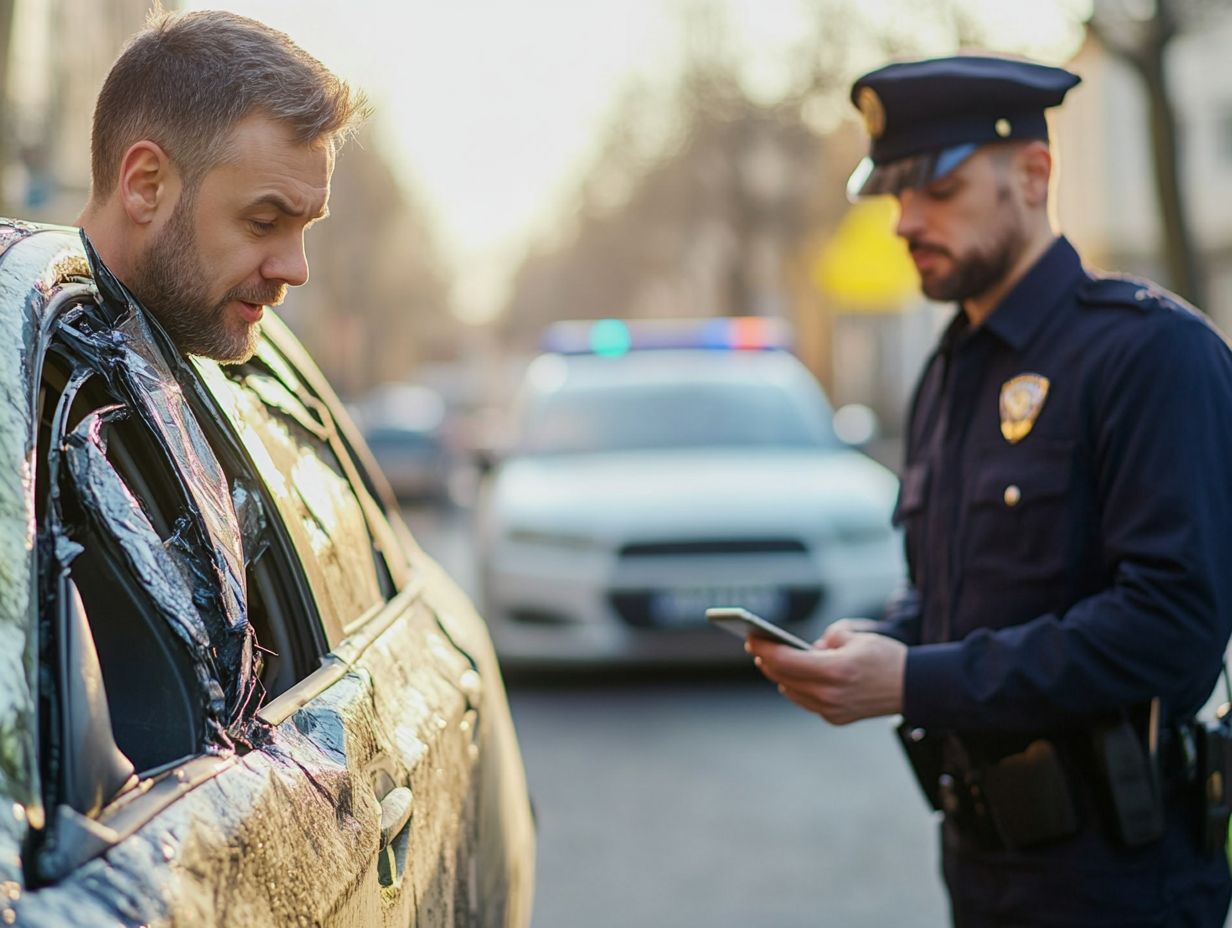How to Handle Claims for Hit-and-Run Accidents?
Hit-and-run accidents can be both traumatizing and bewildering. They often leave you feeling uncertain about your next steps. This article delves into the intricacies of hit-and-run incidents, helping you understand what they entail and recognize common scenarios.
You ll find guidance on the immediate actions to take after such an event, along with a detailed walkthrough of the process for filing a claim with your insurance. It also covers your legal options for compensation and provides practical tips to help prevent these accidents in the future.
By the end, you will gain valuable insights that empower you to navigate the aftermath of a hit-and-run with confidence.
Contents
- Key Takeaways:
- Understanding Hit-and-Run Accidents
- What to Do Immediately After a Hit-and-Run
- Filing a Claim with Your Insurance Company
- Legal Options for Hit-and-Run Victims
- Preventing Hit-and-Run Accidents
- Frequently Asked Questions
- What should I do immediately after a hit-and-run accident?
- Is uninsured motorist coverage necessary for a hit-and-run claim?
- How do I file a claim with my insurance company for a hit-and-run accident?
- What if I don’t have comprehensive coverage for my vehicle?
- What if the driver responsible for the hit-and-run is identified?
- Is there a time limit for filing a hit-and-run accident claim?
Key Takeaways:

- Always prioritize your safety and health after a hit-and-run accident. Seek medical attention and gather evidence at the scene.
- When filing a claim with your insurance company, have all necessary documentation ready and be aware of coverage limitations for hit-and-run incidents.
- If you are a victim of a hit-and-run, consider seeking legal action to receive compensation for damages or injuries sustained.
Understanding Hit-and-Run Accidents
Grasping the nuances of hit-and-run accidents is essential. These incidents occur when drivers flee the scene without providing their information or assisting those injured. This leads to a labyrinth of legal and insurance challenges for victims.
The emotional and financial strain that accompanies such accidents can be daunting. This is especially true when maneuvering through the complexities of personal injury claims and deciphering insurance policies, particularly in states like Indiana and California.
As a victim, you may face escalating medical expenses and the formidable challenge of collecting evidence, all while managing the fallout from a collision with uninsured drivers.
Definition and Common Scenarios
A hit-and-run occurs when a driver involved in a car accident decides to flee the scene without offering their contact details or helping those injured. This can complicate the insurance claim process.
These incidents can happen in various situations, whether it s a quick bumper bump in a crowded parking lot or a more serious collision at a busy intersection where the guilty party suddenly hits the gas and vanishes. In these moments, you might feel frustrated and powerless, especially if you can t gather enough information about the fleeing vehicle.
This is where witness statements come into play; they can provide crucial details that help law enforcement track down the runaway driver.
A thoroughly documented police report can be your best friend in this situation. It serves as key evidence when navigating the insurance claim process and may determine whether you receive compensation for the damages suffered during this ordeal.
What to Do Immediately After a Hit-and-Run
In the unfortunate event of a hit-and-run incident, act quickly to protect yourself and your rights! Prioritize your safety and seek medical attention for any injuries sustained at the scene.
This crucial step can significantly impact your medical bills and insurance claims in the aftermath. Don’t wait your safety and compensation depend on it!
Steps to Take and Evidence to Gather

After you’ve ensured safety at the accident scene, your next critical step is gathering evidence. This involves collecting witness information, capturing photographs of the scene, and documenting any visible damages. All of this information is essential for filing a police report and supporting your insurance claim.
It’s also crucial to note the time, date, and location of the accident, along with specific conditions like weather or road hazards that may have contributed to the incident. Gathering contact information from reliable witnesses can significantly bolster your case.
When the police arrive, providing them with accurate details will be crucial for your case! This will help create a comprehensive report.
Keeping a meticulous record of all medical expenses, including bills and treatment notes, is vital if you’re seeking compensation. Insurance companies need clear proof of the costs from the accident, so being organized is key.
Filing a Claim with Your Insurance Company
Filing a claim with your insurance company after a hit-and-run can be quite a complicated process. Make sure to capture every detail! This will make your claims process much smoother as you’ll need to navigate collision coverage, grasp the nuances of your insurance policy, and assess fault. For guidance, check out what are the steps after a hit-and-run, particularly if the other driver is uninsured.
It s essential to document every detail of the incident to streamline the claims process and ensure you re well-equipped for what lies ahead.
Coverage and Process for Hit-and-Run Claims
To navigate the complexities of hit-and-run claims effectively, it’s crucial for you to have a solid grasp of your auto insurance policy, particularly focusing on collision coverage and uninsured motorist provisions. Collision coverage helps pay for damages to your car in an accident, regardless of who is at fault. Additionally, understanding how to handle an insurance claim for a minor accident is essential, as uninsured motorist provisions act as your safety net when the responsible driver is either unidentifiable or underinsured. These elements can significantly influence your compensation journey.
In a hit-and-run situation, collision coverage is your ally, covering damages to your vehicle regardless of fault, which means quicker repairs for you.
When it comes time to file a claim, start by gathering evidence think photographs and witness statements before you report the incident to your insurance provider. The subsequent claims process typically involves an investigation that may take several weeks. The compensation you receive will vary based on the severity of the damage and your policy limits. By understanding these details, you can better prepare for what lies ahead.
Legal Options for Hit-and-Run Victims
As a hit-and-run victim, you have various legal avenues available to pursue, including seeking compensation through personal injury claims and filing lawsuits against those responsible.
Engaging legal assistance can significantly bolster your chances of successfully navigating the intricate landscape of these cases, particularly given the nuances inherent in each state’s laws.
Filing a Lawsuit and Seeking Compensation

Filing a lawsuit after a hit-and-run can help you get paid for your medical bills and other expenses. Having experienced legal help is essential for navigating the complexities of getting paid.
The legal system can be overwhelming, especially if you’re recovering from trauma. Your first step is to gather all the necessary documentation, including medical records, accident reports, and proof of expenses. Be mindful of specific deadlines that differ by state.
Once your paperwork is in order, the next step is to file a complaint with the appropriate court. This typically involves detailing the incident and outlining the damages you’re seeking.
As you embark on this journey, be prepared for potential obstacles like not enough proof or defenses from the other party. That’s why having expert legal representation is crucial.
Understanding how to calculate compensation accurately considering tangible costs like lost wages as well as intangible damages such as pain and suffering can significantly influence your outcome.
Skilled attorneys are vital in maximizing your recovery, utilizing their knowledge of local laws and court procedures to your advantage.
Preventing Hit-and-Run Accidents
Preventing hit-and-run accidents requires a comprehensive strategy. Advocate for clearer insurance coverage guidelines, raise awareness about the legal penalties faced by drivers who flee the scene, and ensure every driver understands the critical importance of staying at the accident scene.
This strategy reduces risks and encourages drivers to take responsibility, creating safer roads for everyone.
Tips for Avoiding and Dealing with Hit-and-Run Incidents
- Stay aware of your surroundings
- Document the details of the accident scene
- Gather witness information
These actions can significantly enhance your insurance claim process should an incident occur. Maintaining a vigilant mindset while driving can dramatically reduce the likelihood of such incidents. Leveraging technology, like dash cams, can provide essential evidence during an accident, capturing not just the moment of impact but also the surrounding context.
If you find yourself in the unfortunate situation of an incident, it’s vital to remain calm and assess the situation thoroughly. Call the authorities immediately to document the event. Gathering tangible evidence such as photos and witness statements can greatly strengthen your insurance claim, ensuring you’re protected from any unfair repercussions.
Frequently Asked Questions
What should I do immediately after a hit-and-run accident?

Call the police immediately to report the accident! Make sure to get a copy of the police report and any witness statements. Take photos of the damage to your vehicle and the scene of the accident if possible.
Is uninsured motorist coverage necessary for a hit-and-run claim?
While it is not a legal requirement in all states, having uninsured motorist coverage can greatly help in covering the costs of a hit-and-run accident. It is always best to have this coverage as a precaution.
How do I file a claim with my insurance company for a hit-and-run accident?
Contact your insurance company as soon as possible to report the accident. Provide them with all the necessary information, including the police report and witness statements. They will guide you through the claims process and help you determine your coverage.
What if I don’t have comprehensive coverage for my vehicle?
If you do not have comprehensive coverage, you may still be able to file a claim with your insurance company for a hit-and-run accident. However, keep in mind that you may be responsible for paying a deductible and your coverage may be limited.
What if the driver responsible for the hit-and-run is identified?
If the driver responsible for the hit-and-run is found, you can take action! File a claim against their insurance or pursue legal steps. Be sure to gather all the evidence you can; navigating the claims process is crucial for your success!
Is there a time limit for filing a hit-and-run accident claim?
The time limit for filing a hit-and-run claim is important. Don t wait! Check with your insurance company or an attorney to find out your deadline. Acting quickly can make all the difference!






